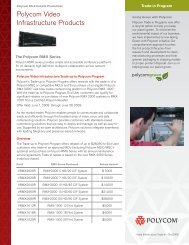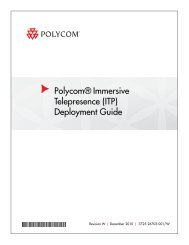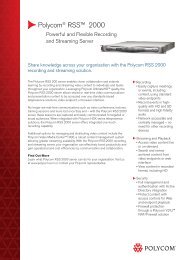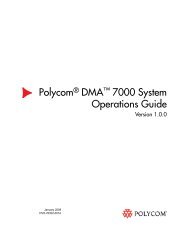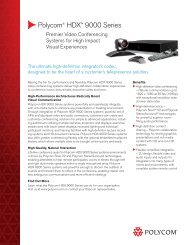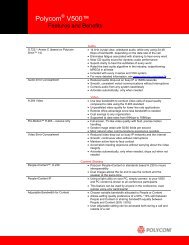KIRK Wireless Server 300 and 6000 Provisioning Guide - Polycom
KIRK Wireless Server 300 and 6000 Provisioning Guide - Polycom
KIRK Wireless Server 300 and 6000 Provisioning Guide - Polycom
Create successful ePaper yourself
Turn your PDF publications into a flip-book with our unique Google optimized e-Paper software.
<strong>KIRK</strong> <strong>Wireless</strong> <strong>Server</strong> <strong>300</strong> & <strong>6000</strong><br />
<strong>Provisioning</strong><br />
Version 2.2<br />
©2009 <strong>Polycom</strong>, Inc. All rights reserved. <strong>Polycom</strong> <strong>and</strong> the <strong>Polycom</strong> logo design are registered trademarks<br />
of <strong>Polycom</strong>, Inc. All other trademarks are the property of their respective owners. Information is subject to change without notice.
<strong>Provisioning</strong> guide for KWS<strong>300</strong> <strong>and</strong> KWS<strong>6000</strong><br />
Table of content<br />
1. INTRODUCTION ......................................................................................................................... 3<br />
1.1 DOCUMENT HISTORY .............................................................................................................. 3<br />
2. PROVISIONING ARCHITECTURE ......................................................................................... 4<br />
2.1 DHCP SERVER ........................................................................................................................ 4<br />
2.2 PROVISIONING SERVER ........................................................................................................... 4<br />
2.3 XML FILE FORMATTING ......................................................................................................... 5<br />
3. SETTING UP PROVISIONING ON KWS ................................................................................ 6<br />
3.1 SETTING UP ACCESS TO PROVISIONING SERVER ..................................................................... 6<br />
3.2 AUTOMATIC CHECK FOR NEW FIRMWARE, CONFIGURATION AND USER DATA ...................... 7<br />
3.2.1 Polling ............................................................................................................................. 7<br />
3.2.2 SIP NOTIFY check-sync .................................................................................................. 7<br />
3.3 UPDATING THE FIRMWARE, CONFIGURATION DATA OR USER DATA ..................................... 8<br />
3.3.1 Firmware update ............................................................................................................. 8<br />
3.3.2 Configuration update ...................................................................................................... 8<br />
3.3.3 User list update ............................................................................................................... 9<br />
4. APPENDIX A – CONFIGURATION FILE PARAMETER DESCRIPTION ...................... 10<br />
5. APPENDIX B – CONFIGURATION FILE EXAMPLE......................................................... 17<br />
6. APPENDIX C – USERS XML PARAMETERS ...................................................................... 19<br />
7. APPENDIX D – USERS XML EXAMPLE .............................................................................. 20<br />
©2009 <strong>Polycom</strong>, Inc. All rights reserved. <strong>Polycom</strong> <strong>and</strong> the <strong>Polycom</strong> logo design are registered trademarks<br />
of <strong>Polycom</strong>, Inc. All other trademarks are the property of their respective owners. Information is subject to change without notice.
<strong>Provisioning</strong> guide for KWS<strong>300</strong> <strong>and</strong> KWS<strong>6000</strong><br />
1. Introduction<br />
The purpose of provisioning is to simplify mass configuration <strong>and</strong> deployment. With provisioning it is<br />
possible to have a centralized repository for h<strong>and</strong>ling firmware, configuration files <strong>and</strong> user lists for<br />
all devices.<br />
1.1 Document History<br />
Date Version Description<br />
2009-04-24 1.0 First Revision<br />
2009-09-22 2.0 Restructure of document <strong>and</strong> added configuration parameters<br />
for KWS<strong>300</strong> PCS04__ & KWS<strong>6000</strong> PCS04__<br />
2010-03-31 2.2 Added note about TFTP <strong>and</strong> path.<br />
Changed KWS<strong>300</strong> from static to DHCP assigned IP address.<br />
©2009 <strong>Polycom</strong>, Inc. All rights reserved. <strong>Polycom</strong> <strong>and</strong> the <strong>Polycom</strong> logo design are registered trademarks<br />
of <strong>Polycom</strong>, Inc. All other trademarks are the property of their respective owners. Information is subject to change without notice.
<strong>Provisioning</strong> guide for KWS<strong>300</strong> <strong>and</strong> KWS<strong>6000</strong><br />
2. <strong>Provisioning</strong> Architecture<br />
The KWS<strong>300</strong> <strong>and</strong> KWS<strong>6000</strong> use a common method for provisioning. If a provisioning server is specified<br />
(either statically or through a DHCP-server), the KWS contacts the provisioning server to<br />
check/update its firmware, configuration <strong>and</strong> user list.<br />
<strong>Provisioning</strong> <strong>Server</strong><br />
Provides:<br />
- Firmware version<br />
- Firmware image<br />
- Configuration file<br />
- User list<br />
2.1 DHCP <strong>Server</strong><br />
Figure 1: KWS<strong>300</strong> <strong>and</strong> KWS<strong>6000</strong> provisioning architecture.<br />
When using DHCP, option 66 (TFTP server name) can be used to provide the provisioning server<br />
URL. This is a string type option configured on the DHCP server of the network.<br />
2.2 <strong>Provisioning</strong> <strong>Server</strong><br />
A central provisioning server keeps firmware <strong>and</strong> configuration files for the devices. The firmware<br />
<strong>and</strong> configuration is pulled from the provisioning server by the devices using FTP, TFTP or HTTP.<br />
The provisioning server provides the following files to the KWS:<br />
File Description<br />
Firmwarefilename.bin<br />
e.g. kws<strong>300</strong>firmware.bin or<br />
kws<strong>6000</strong>firmware.bin<br />
tftp, ftp, http<br />
DHCP <strong>Server</strong> (optional)<br />
Provides:<br />
- IP address<br />
- Subnet Mask<br />
- Gateway (Router)<br />
- DNS <strong>Server</strong><br />
- Option 66 (Boot <strong>Server</strong> Host Name)<br />
A binary file containing the firmware image. The<br />
filename is defined in the XML configuration file<br />
or entered in the <strong>Provisioning</strong> -> Firmware -><br />
KWS field in the web GUI<br />
©2009 <strong>Polycom</strong>, Inc. All rights reserved. <strong>Polycom</strong> <strong>and</strong> the <strong>Polycom</strong> logo design are registered trademarks<br />
<strong>KIRK</strong> <strong>Wireless</strong> <strong>Server</strong><br />
<strong>300</strong> or <strong>6000</strong><br />
<strong>KIRK</strong> <strong>Wireless</strong> <strong>Server</strong><br />
<strong>300</strong> or <strong>6000</strong><br />
<strong>KIRK</strong> <strong>Wireless</strong> <strong>Server</strong><br />
<strong>300</strong> or <strong>6000</strong><br />
of <strong>Polycom</strong>, Inc. All other trademarks are the property of their respective owners. Information is subject to change without notice.<br />
.<br />
.<br />
.
<strong>Provisioning</strong> guide for KWS<strong>300</strong> <strong>and</strong> KWS<strong>6000</strong><br />
Firmwarefilename.bin.ver<br />
e.g. kws<strong>300</strong>firmware.bin.ver or<br />
kws<strong>6000</strong>firmware.bin.ver<br />
-config.xml<br />
e.g. 0013d1800032-config.xml<br />
- users.xml<br />
e.g. 0013d1800032-users.xml<br />
2.3 XML File Formatting<br />
A text file with text describing current firmware<br />
version. For example “PCS03 18860”. This file<br />
must have the name of the binary firmware file<br />
with .ver appended. The .ver file is included in the<br />
firmware package<br />
A XML formatted file containing the configuration<br />
– see APPENDIX B – Configuration file<br />
example<br />
A XML formatted file containing User data – see<br />
APPENDIX D – Users XML Example<br />
XML is a st<strong>and</strong>ard format <strong>and</strong> a few things must be considered when creating <strong>and</strong> editing XML files.<br />
The character encoding of the XML file must match the character encoding specified in the encoding<br />
attribute of the header in the file. Below is a snippet of XML where the header specifies the encoding<br />
as UTF-8:<br />
<br />
<br />
...<br />
<br />
If no encoding is specified in the header the default format is UTF-8. If the encoding does not match<br />
international characters (æ, ö <strong>and</strong> more) may be obscured or the file cannot be parsed.<br />
In order to avoid problems with importing the XML files it is advisable to validate the XML with an<br />
external tool before using the files.<br />
Example: If a users XML file is exported from the KWS it is encoded in UTF-8. If the exported file is<br />
edited with an editor that is not encoding aware (E.g. Windows Notepad) <strong>and</strong> international letters are<br />
added or changed these may be saved in Windows-1252 encoding. The KWS will not be able to import<br />
the file because the encoding of the characters does not match the encoding of the file.<br />
©2009 <strong>Polycom</strong>, Inc. All rights reserved. <strong>Polycom</strong> <strong>and</strong> the <strong>Polycom</strong> logo design are registered trademarks<br />
of <strong>Polycom</strong>, Inc. All other trademarks are the property of their respective owners. Information is subject to change without notice.
<strong>Provisioning</strong> guide for KWS<strong>300</strong> <strong>and</strong> KWS<strong>6000</strong><br />
3. Setting up provisioning on KWS<br />
3.1 Setting up Access to <strong>Provisioning</strong> <strong>Server</strong><br />
Figure 2: Screen dump from the KWS<strong>300</strong> Configuration -> <strong>Provisioning</strong> Page.<br />
The KWS needs to know the protocol <strong>and</strong> address of the provisioning server containing firmware,<br />
configuration <strong>and</strong> user-data. This information is h<strong>and</strong>led as an URL in the format:<br />
[://[:@]][/]<br />
Note: The [/] part of the URL is not supported for TFTP.<br />
Examples:<br />
10.0.0.10 ;tftp used as default protocol<br />
tftp://provisioning.test.com<br />
ftp://192.168.0.1<br />
ftp://user:password@provisioning.example.com<br />
http://server.example.com/boot.<br />
The URL can be obtained through the configuration file or through DHCP.<br />
The KWS can use the following methods to obtain the provisioning server URL:<br />
Disabled (The KWS will not use provisioning)<br />
Static (The administrator must manually specify the URL of the provisioning server)<br />
DHCP Option 66 (default)<br />
If no provisioning server is configured or obtained, the KWS will not use auto provisioning.<br />
©2009 <strong>Polycom</strong>, Inc. All rights reserved. <strong>Polycom</strong> <strong>and</strong> the <strong>Polycom</strong> logo design are registered trademarks<br />
of <strong>Polycom</strong>, Inc. All other trademarks are the property of their respective owners. Information is subject to change without notice.
<strong>Provisioning</strong> guide for KWS<strong>300</strong> <strong>and</strong> KWS<strong>6000</strong><br />
Three protocols are available for downloading firmware <strong>and</strong> configuration: TFTP, FTP <strong>and</strong> HTTP.<br />
All of the protocols are available at the target <strong>and</strong> no additional software is required. Which protocol<br />
to use is specified through the provisioning server‟s URL.<br />
3.2 Automatic check for new Firmware, Configuration <strong>and</strong> User data<br />
When new firmware, configuration or user data files are made available at the provisioning server, the<br />
KWS must download it. The KWS needs to know when new data is available. Two methods are supplied<br />
for this: Periodic polling <strong>and</strong> SIP notifications.<br />
3.2.1 Polling<br />
When polling is selected the server will initiate a check for updates by itself. The check will be performed<br />
at a specified interval or at a specific time of day.<br />
3.2.2 SIP NOTIFY check-sync<br />
The preferred way to h<strong>and</strong>le updates is by notifying the KWS that updates are available. This is<br />
with the SIP NOTIFY method <strong>and</strong> the event “check-sync”. A check-sync event is sent to one of<br />
extensions/usernames h<strong>and</strong>led by the KWS <strong>and</strong> when it is received the KWS initiates a check<br />
updates. This is illustrated in<br />
Figure 3.<br />
CallH<strong>and</strong>ler <strong>Provisioning</strong> <strong>Server</strong> Provisioned Device<br />
SIP-NOTIFY check-sync<br />
200 OK<br />
Check for new firmware<br />
Status<br />
Check for new configuration<br />
Status<br />
Check for new user list<br />
Status<br />
©2009 <strong>Polycom</strong>, Inc. All rights reserved. <strong>Polycom</strong> <strong>and</strong> the <strong>Polycom</strong> logo design are registered trademarks<br />
of <strong>Polycom</strong>, Inc. All other trademarks are the property of their respective owners. Information is subject to change without notice.
<strong>Provisioning</strong> guide for KWS<strong>300</strong> <strong>and</strong> KWS<strong>6000</strong><br />
Figure 3: Receiving SIP NOTIFY check-sync.<br />
3.3 Updating the Firmware, Configuration Data or User Data<br />
The KWS will be able to automatically download firmware, configuration <strong>and</strong> users from the provisioning<br />
server. This section specifies how this is done.<br />
3.3.1 Firmware update<br />
The firmware will be stored as a file at the provisioning server. Together with the firmware file a<br />
firmware version file will be stored. This file is downloaded to determine the version of the firmware<br />
without actually downloading the firmware file, to keep the network load at a minimum.<br />
For flexibility, the name of the firmware file is stored in the XML configuration.<br />
Below is an illustration of the firmware update process:<br />
Download<br />
kws<strong>300</strong>firmware.bin.ver<br />
kws<strong>6000</strong>firmware.bin.ver<br />
Different<br />
version?<br />
No<br />
Done<br />
Yes<br />
Figure 4: Firmware update process<br />
The firmware version specified in the “.ver” file is compared with the current active firmware version<br />
(the version that is currently running). Immediately after the firmware is updated in the flash the KWS<br />
is rebooted to make the (updated) firmware residing in the flash become the active firmware.<br />
©2009 <strong>Polycom</strong>, Inc. All rights reserved. <strong>Polycom</strong> <strong>and</strong> the <strong>Polycom</strong> logo design are registered trademarks<br />
Download<br />
kws<strong>300</strong>firmware.bin<br />
kws<strong>6000</strong>firmware.bin<br />
Program flash<br />
Reboot<br />
of <strong>Polycom</strong>, Inc. All other trademarks are the property of their respective owners. Information is subject to change without notice.
<strong>Provisioning</strong> guide for KWS<strong>300</strong> <strong>and</strong> KWS<strong>6000</strong><br />
3.3.2 Configuration update<br />
Figure 5 illustrates the configuration update process.<br />
Figure 5: Configuration update process<br />
The XML configuration file is downloaded <strong>and</strong> imported into the KWS configuration by replacing the<br />
existing data. This secures that data located on the provisioning server <strong>and</strong> at the KWS are identical.<br />
The -config.xml replaces the internal configuration. This way the configuration is 100% controlled<br />
by the provisioning server.<br />
Be aware: The network configuration of the device is a part of the config.xml. If the network configuration<br />
is invalid/missing the device will not be able to boot <strong>and</strong> a reset to defaults is required. Here is<br />
an example of a sufficient network configuration for DHCP:<br />
<br />
dhcp<br />
<br />
This way it is not necessary to configure the network configuration in the provisioning.<br />
3.3.3 User list update<br />
The users are stored in a separate “-users.xml” file. In an existing KWS installation, the user<br />
list file can be retrieved by clicking Users -> Import/Export -> Save XML format.<br />
Each record must as a minimum have a username field.<br />
©2009 <strong>Polycom</strong>, Inc. All rights reserved. <strong>Polycom</strong> <strong>and</strong> the <strong>Polycom</strong> logo design are registered trademarks<br />
of <strong>Polycom</strong>, Inc. All other trademarks are the property of their respective owners. Information is subject to change without notice.
<strong>Provisioning</strong> guide for KWS<strong>300</strong> <strong>and</strong> KWS<strong>6000</strong><br />
Changes in the “-users.xml” file do not require a reboot of the system.<br />
©2009 <strong>Polycom</strong>, Inc. All rights reserved. <strong>Polycom</strong> <strong>and</strong> the <strong>Polycom</strong> logo design are registered trademarks<br />
of <strong>Polycom</strong>, Inc. All other trademarks are the property of their respective owners. Information is subject to change without notice.
<strong>Provisioning</strong> guide for KWS<strong>300</strong> <strong>and</strong> KWS<strong>6000</strong><br />
4. APPENDIX A – Configuration file parameter description<br />
Parameter Description Values<br />
DECT<br />
config.dect.auto_create_users Adds a new user when a DECT<br />
h<strong>and</strong>set tries to subscribe to the<br />
true – auto create users<br />
system.<br />
false – disabled<br />
config.dect.send_date_time Specifies if the date <strong>and</strong> time<br />
will be sent to the h<strong>and</strong>sets.<br />
config.dect.subscription_allowed Specifies if h<strong>and</strong>set subscription<br />
is allowed.<br />
config.dect.auth_call Specifies if DECT authentication<br />
should be used when establishing<br />
calls.<br />
config.dect.encrypt_voice_data Specifies if DECT encryption<br />
should be used for voice calls.<br />
Network<br />
config.network.bootproto Specifies if the IP configuration<br />
is provided by DHCP or<br />
static<br />
©2009 <strong>Polycom</strong>, Inc. All rights reserved. <strong>Polycom</strong> <strong>and</strong> the <strong>Polycom</strong> logo design are registered trademarks<br />
Default: false<br />
true – send date & time<br />
false – do not send date & time<br />
Default: true<br />
true – subscription allowed<br />
false – subscription disallowed<br />
of <strong>Polycom</strong>, Inc. All other trademarks are the property of their respective owners. Information is subject to change without notice.<br />
Default: true<br />
true – DECT authentication is required<br />
when establishing calls.<br />
false – DECT authentication of<br />
calls is disabled.<br />
Default: true<br />
Disabled – DECT encryption is<br />
disabled.<br />
Enabled – DECT encryption is<br />
enabled.<br />
Enforced – DECT encryption is<br />
enforced <strong>and</strong> calls are terminated<br />
if the h<strong>and</strong>set do not support encryption.<br />
dhcp – get IP config using<br />
DHCP<br />
static – the IP config is statically<br />
defined<br />
Default: static<br />
KWS<strong>300</strong>: Starting with devices<br />
produced with firmware release<br />
PCS05B_, the default is DHCP. If<br />
DHCP is not available, it will fall<br />
back to the configured IP address.<br />
config.network.dns1 Specifies the Primary DNS Default: Empty<br />
config.network.dns2 Specifies the secondary DNS Default: Empty
<strong>Provisioning</strong> guide for KWS<strong>300</strong> <strong>and</strong> KWS<strong>6000</strong><br />
config.network.domain Specifies the name of the domain<br />
the system belongs to.<br />
Default: Empty<br />
config.network.gateway Specifies the IP address of the<br />
default gateway.<br />
Default: Empty<br />
config.network.ipaddr<br />
config.network.mtu<br />
Specifies the IP address of the<br />
system.<br />
Specifies the Maximum<br />
Transmission Unit.<br />
Default: 192.168.0.1<br />
Default: Empty<br />
config.network.netmask Specifies the network mask. Default: 255.255.255.0<br />
config.network.ntp<br />
config.network.timezone<br />
<strong>Provisioning</strong><br />
Specifies the address of the<br />
NTP server.<br />
Specifies the time zone.<br />
Default: Empty<br />
Default: CET-1CEST-<br />
2,M3.5.0/02:00:00,M10.5.0/<br />
03:00:00<br />
config.provisioning.check.check_sync Specifies how the KWS will<br />
disabled – do not react.<br />
react to SIP NOTIFY checksync<br />
events.<br />
reboot – reboot <strong>and</strong> check for updates.<br />
config.provisioning.check.interval Specifies an interval for checking<br />
for updates.<br />
config.provisioning.check.time Specifies a specific time for<br />
checking each day. The format<br />
is HH:MM<br />
config.provisioning.server.method Specifies how the KWS will<br />
obtain the provisioning server<br />
address.<br />
©2009 <strong>Polycom</strong>, Inc. All rights reserved. <strong>Polycom</strong> <strong>and</strong> the <strong>Polycom</strong> logo design are registered trademarks<br />
of <strong>Polycom</strong>, Inc. All other trademarks are the property of their respective owners. Information is subject to change without notice.<br />
update – check for updates <strong>and</strong><br />
reboot if necessary.<br />
Default: disabled<br />
0 – do not check for updates periodically.<br />
>= 1 – interval in minutes.<br />
Default: 0<br />
00:00 – 23:59<br />
Default: Empty<br />
Specifies how the KWS will obtain<br />
the provisioning server address.<br />
dhcp – obtain from DHCP option<br />
66.<br />
static – use static configured.<br />
disabled – do not check for updates.<br />
Default: dhcp
<strong>Provisioning</strong> guide for KWS<strong>300</strong> <strong>and</strong> KWS<strong>6000</strong><br />
config.provisioning.server.url Specifies the static provisioning<br />
server URL from where the<br />
KWS will retrieve configuration<br />
information. The format is<br />
[://[:@]]<br />
[/]. Protocol can<br />
be either tftp, ftp or http.<br />
It is optional to specify a protocol.<br />
If the protocol is not specified<br />
the KWS will default to<br />
tftp.<br />
Note: The [/] part of the<br />
URL is not supported for<br />
TFTP.<br />
config.provisioning.firmware.kws Specifies the name of the<br />
firmware image to use for the<br />
KWS. The KWS will check for<br />
a version file <strong>and</strong> a binary file.<br />
They must be located as<br />
/.ver <strong>and</strong><br />
/<br />
config.provisioning.users.check Specifies if the users list should<br />
be loaded.<br />
Security<br />
config.security.force_https Specifies if the system should<br />
enforce remote access security<br />
using HTTPS (TLS).<br />
©2009 <strong>Polycom</strong>, Inc. All rights reserved. <strong>Polycom</strong> <strong>and</strong> the <strong>Polycom</strong> logo design are registered trademarks<br />
of <strong>Polycom</strong>, Inc. All other trademarks are the property of their respective owners. Information is subject to change without notice.<br />
Example:<br />
ftp://kws:ip<strong>6000</strong>@boot.example.co<br />
m/phones or 192.168.0.1<br />
Default: Empty<br />
Example: kws<strong>300</strong>-flash.bin<br />
Default: Empty<br />
true – load users list<br />
false – do not load the user list<br />
Default: Empty<br />
true – force HTTPS (TLS)<br />
false – use HTTP<br />
config.security.username Username for the user who log<br />
on to the web GUI.<br />
Default: false<br />
Default: admin<br />
config.security.password Encrypted password for the Default KWS<strong>300</strong>: kws<strong>300</strong> (en-<br />
SIP<br />
user who log on to the web<br />
GUI.<br />
crypted)<br />
Default KWS<strong>6000</strong>: ip<strong>6000</strong> (encrypted)<br />
config.sip.auth.password Specifies the default password<br />
for the h<strong>and</strong>set authentication<br />
(if no h<strong>and</strong>set specific authentication<br />
password is specified).<br />
Default: Empty<br />
config.sip.auth.username Specifies the default username<br />
for the h<strong>and</strong>set authentication<br />
(if no h<strong>and</strong>set specific authentication<br />
username is specified).<br />
Default: Empty<br />
config.sip.defaultdomain Specifies the default domain<br />
for the h<strong>and</strong>set (if no h<strong>and</strong>set<br />
specific domain is specified).<br />
Default: Empty
<strong>Provisioning</strong> guide for KWS<strong>300</strong> <strong>and</strong> KWS<strong>6000</strong><br />
config.sip.dtmf.duration Specifies the length of the<br />
DTMF tones in milliseconds.<br />
Default: 270<br />
config.sip.dtmf.info Specifies if the keypad signaling<br />
should be sent as SIP INtrue<br />
– send as SIP INFO<br />
FO.<br />
false – do not send as SIP INFO<br />
config.sip.dtmf.rtp Specifies if the keypad signaling<br />
should be sent as RTP<br />
packets with DTMF code.<br />
©2009 <strong>Polycom</strong>, Inc. All rights reserved. <strong>Polycom</strong> <strong>and</strong> the <strong>Polycom</strong> logo design are registered trademarks<br />
Default: false<br />
true – send as RTP<br />
false – no not send as RTP<br />
config.sip.dtmf.rtp_payload_type Specifies the payload type for<br />
RFC2833 in SDP offers.<br />
Default: true<br />
Default: 96<br />
config.sip.localport Specifies the SIP port. Default: 5060<br />
config.sip.maxforwards Specifies the maximum number<br />
of times the SIP messages<br />
can be forwarded through proxies.<br />
Default: 70<br />
config.sip.media.codecs Specifies the codec priority. Default:<br />
1,2 (for KWS<strong>300</strong>)<br />
config.sip.media.port<br />
config.sip.media.ptime<br />
Specifies the start port for media.<br />
Specifies the packet duration<br />
for media (milliseconds).<br />
64,1,2,0,0,0 (for KWS<strong>6000</strong>)<br />
Default: 58000<br />
Default: 20<br />
config.sip.media.symmetric Specifies if the KWS should<br />
require symmetric RTP for the<br />
true – require symmetric RTP<br />
media.<br />
false – do not require symmetric<br />
RTP<br />
config.sip.media.tos Specifies the<br />
TOS/Diffserv.<br />
media‟s<br />
config.sip.mwi.enable Enables the MWI (Message<br />
Waiting Indicator).<br />
Default: true<br />
Default: 184<br />
true – MWI enabled<br />
false – MWI disabled<br />
config.sip.mwi.expire Specifies the MWI subscrip-<br />
Default: true<br />
Default: 3600<br />
tion‟s expiration<br />
(seconds).<br />
time<br />
config.sip.mwi.subscribe Enables MWI subscription. true – MWI subscription enabled<br />
config.sip.onholdtone Specifies if the h<strong>and</strong>set should<br />
play the on-hold tone when put<br />
on-hold.<br />
of <strong>Polycom</strong>, Inc. All other trademarks are the property of their respective owners. Information is subject to change without notice.<br />
false – MWI subscription disabled<br />
Default: false<br />
true – on-hold tone enabled<br />
false – on-hold-tone disabled<br />
Default: true
<strong>Provisioning</strong> guide for KWS<strong>300</strong> <strong>and</strong> KWS<strong>6000</strong><br />
config.sip.pound_dials_overlap Specifies if „#‟ should dial in<br />
overlap dialing.<br />
config.sip.proxy.domain<br />
config.sip.proxy.domain[2-4]<br />
config.sip.proxy.port<br />
config.sip.proxy.port[2-4]<br />
config.sip.proxy.priority<br />
config.sip.proxy.priority[2-4]<br />
config.sip.proxy.weight<br />
config.sip.proxy.weight[2-4]<br />
Specifies addresses for SIP<br />
proxies.<br />
Specifies the port for SIP proxies.<br />
Specifies the priority for using<br />
a SIP proxy. Proxies with lowest<br />
priority will be preferred<br />
<strong>and</strong> higher priorities will be<br />
used for failover.<br />
Specifies the weight for using a<br />
proxy. If more proxies have the<br />
same priority the KWS will do<br />
load balancing using the weight<br />
to determine how much each<br />
proxy will be loaded.<br />
config.sip.proxy.transport Specifies the transport mechanism<br />
used for SIP messages.<br />
config.sip.registration_expire Specifies the number of<br />
seconds before a SIP registra-<br />
tion will be renewed.<br />
config.sip.send_to_current_registrar Specifies if the system should<br />
send all messages to the current<br />
registrar.<br />
config.sip.separate_endpoint_ports Specifies if the endpoints<br />
should register on separate<br />
ports.<br />
config.sip.showstatustext Show the information for the<br />
call status in the h<strong>and</strong>set display<br />
(ring, hold etc)<br />
©2009 <strong>Polycom</strong>, Inc. All rights reserved. <strong>Polycom</strong> <strong>and</strong> the <strong>Polycom</strong> logo design are registered trademarks<br />
of <strong>Polycom</strong>, Inc. All other trademarks are the property of their respective owners. Information is subject to change without notice.<br />
true – „#‟ dials in overlap dialing<br />
false – „#‟ does not dial in overlap<br />
dialing<br />
Default: false<br />
Default: Empty<br />
Default: Empty<br />
Values: 1-4<br />
Default: 1,2,3,4<br />
Values: 0-100<br />
Default: 100<br />
UDPonly – use UDP <strong>and</strong> simple<br />
DNS for resolving IP addresses<br />
DNSsrv – use UDP <strong>and</strong> DNSSrv<br />
for resolving IP addresses<br />
Default: UDPonly<br />
Default: 3600<br />
true – sends all messages to current<br />
registrar<br />
false – does not send all messages<br />
to current registrar<br />
Default: false<br />
true – register endpoints on separate<br />
ports<br />
false – don‟t register endpoints on<br />
separate ports<br />
Default: false<br />
true: Show text<br />
false: Text is not shown<br />
Default: true<br />
config.sip.tos Specifies the SIP TOS/Diffserv Default: 96
<strong>Provisioning</strong> guide for KWS<strong>300</strong> <strong>and</strong> KWS<strong>6000</strong><br />
Phonebook<br />
config.phonebook.encoding Specifies the character encoding<br />
of the imported CSV file.<br />
config.phonebook.ldap_attributes<br />
The LDAP attributes to retrieve<br />
<strong>and</strong> use.<br />
config.phonebook.ldap_base The base path where the users<br />
are located in the LDAP structure.<br />
config.phonebook.ldap_bind_password Password used to login to the<br />
LDAP server.<br />
config.phonebook.ldap_bind_user Username used to login to the<br />
config.phonebook.ldap_filter<br />
LDAP server.<br />
The filter used for the LDAP<br />
query. The (objectClass= person)<br />
filter can be used successfully<br />
in most cases.<br />
config.phonebook.ldap_names The attribute names assigned to<br />
the Attributes specified, separated<br />
by a comma.<br />
config.phonebook.ldap_prefixes The phone number prefixes to<br />
strip, separated by a comma.<br />
For example, if the phone<br />
number is +45678912345, <strong>and</strong><br />
that user has the 12345 extension,<br />
then “+456789” is specified<br />
in the Strip prefixes field.<br />
config.phonebook.ldap_refresh_interval The interval in seconds for<br />
querying the LDAP server for<br />
updates.<br />
config.phonebook.ldap_uri The URI of the LDAP server.<br />
config.phonebook.source The source of the phone book<br />
data.<br />
Application<br />
©2009 <strong>Polycom</strong>, Inc. All rights reserved. <strong>Polycom</strong> <strong>and</strong> the <strong>Polycom</strong> logo design are registered trademarks<br />
utf-8<br />
iso8859-1<br />
windows-1252<br />
Default - utf-8<br />
of <strong>Polycom</strong>, Inc. All other trademarks are the property of their respective owners. Information is subject to change without notice.<br />
Relevant attributes provided by the<br />
LDAP server.<br />
Base path from LDAP server.<br />
Valid LDAP password.<br />
Valid LDAP user name.<br />
A valid LDAP filter.<br />
Text strings.<br />
Phone number to strip.<br />
A number of seconds.<br />
A valid LDAP URI.<br />
disabled – do not enable the phonebook.<br />
csv – import phone book from<br />
CSV file.<br />
ldap – query LDAP server for<br />
phone book data.
<strong>Provisioning</strong> guide for KWS<strong>300</strong> <strong>and</strong> KWS<strong>6000</strong><br />
config.application.enable_msf<br />
config.application.username<br />
config.application.password<br />
config.application.enable_rpc<br />
UPnP<br />
config.upnp.enable<br />
config.upnp.broadcast<br />
Specifies if the MSF application<br />
interface is enabled.<br />
Specifies the username required<br />
for applications to log<br />
©2009 <strong>Polycom</strong>, Inc. All rights reserved. <strong>Polycom</strong> <strong>and</strong> the <strong>Polycom</strong> logo design are registered trademarks<br />
of <strong>Polycom</strong>, Inc. All other trademarks are the property of their respective owners. Information is subject to change without notice.<br />
in.<br />
Specifies the encrypted password<br />
required for applications<br />
to log in.<br />
Specifies if the XML-RPC<br />
application interface is<br />
enabled.<br />
Specifies if UPnP support is<br />
enabled. If enabled the device<br />
will respond to UPnP broadcasts.<br />
true – The MSF interface is<br />
enabled <strong>and</strong> applications can connect.<br />
false – The MSF interface is disabled.<br />
Default: true<br />
Default: “GW-DECT/admin”<br />
Default:<br />
“f621c2268a8df24955ef4052bfbb<br />
80cf” (password “ip<strong>6000</strong>” encrypted)<br />
true – The XML-RPC interface is<br />
enabled <strong>and</strong> applications can connect.<br />
false – The XML-RPC interface is<br />
disabled.<br />
Default: false<br />
Values: true/false<br />
Default: true<br />
Specifies if UPnP announce- Values: true/false<br />
ments are broadcasted. If<br />
enabled the device will pe- Default: false<br />
riodically broadcast announcements.
<strong>Provisioning</strong> guide for KWS<strong>300</strong> <strong>and</strong> KWS<strong>6000</strong><br />
5. APPENDIX B – Configuration file example<br />
<br />
<br />
<br />
true<br />
true<br />
true<br />
<br />
<br />
true<br />
<br />
<br />
static<br />
192.168.0.5<br />
example.com<br />
192.168.0.1<br />
192.168.0.100<br />
0<br />
255.255.240.0<br />
192.168.0.5<br />
GMT-1<br />
<br />
<br />
utf-8<br />
displayName, telephoneNumber<br />
OU=Users,OU=Site,DC=example,DC=company,DC=com<br />
XXXX_XXXX<br />
someone<br />
(objectClass=person)<br />
Name, Phone<br />
+4576281,76281,+45<br />
3600<br />
ldap://ldap.example.com<br />
ldap<br />
<br />
<br />
false<br />
XXXXXXXXXXXXXXXXXXXXXXXX<br />
admin<br />
<br />
<br />
<br />
1234<br />
someone<br />
<br />
example.com<br />
<br />
270<br />
false<br />
true<br />
96<br />
96<br />
<br />
©2009 <strong>Polycom</strong>, Inc. All rights reserved. <strong>Polycom</strong> <strong>and</strong> the <strong>Polycom</strong> logo design are registered trademarks<br />
of <strong>Polycom</strong>, Inc. All other trademarks are the property of their respective owners. Information is subject to change without notice.
<strong>Provisioning</strong> guide for KWS<strong>300</strong> <strong>and</strong> KWS<strong>6000</strong><br />
5060<br />
70<br />
<br />
1,2,0,0,0,0<br />
58000<br />
20<br />
true<br />
0<br />
<br />
<br />
true<br />
3600<br />
false<br />
<br />
true<br />
true<br />
<br />
sip.example.com<br />
5060<br />
UDPonly<br />
<br />
3600<br />
false<br />
false<br />
true<br />
0<br />
<br />
<br />
©2009 <strong>Polycom</strong>, Inc. All rights reserved. <strong>Polycom</strong> <strong>and</strong> the <strong>Polycom</strong> logo design are registered trademarks<br />
of <strong>Polycom</strong>, Inc. All other trademarks are the property of their respective owners. Information is subject to change without notice.
<strong>Provisioning</strong> guide for KWS<strong>300</strong> <strong>and</strong> KWS<strong>6000</strong><br />
6. APPENDIX C – Users XML Parameters<br />
Parameter Description Values<br />
users.user.ipei The DECT IPEI of the users h<strong>and</strong>set A valid IPEI in the format<br />
XXXXX XXXXXXX or empty.<br />
users.user.accesscode Access code required for subscribing A number with 0-8 digits.<br />
the h<strong>and</strong>set to the system.<br />
users.user.st<strong>and</strong>bytext The text displayed in the h<strong>and</strong>set A text string.<br />
when idle.<br />
users.user.username The user name / extension used when<br />
communicating with the SIP server<br />
©2009 <strong>Polycom</strong>, Inc. All rights reserved. <strong>Polycom</strong> <strong>and</strong> the <strong>Polycom</strong> logo design are registered trademarks<br />
A valid SIP user name.<br />
This field is required.<br />
users.user.domain SIP domain for the user. Used if the A valid domain name.<br />
user will have a different domain than<br />
the system default.<br />
users.user.displayname The display name send with SIP<br />
requests.<br />
A valid SIP display name.<br />
users.user.authuser User name for authenticating the user. A valid SIP authentication user<br />
name.<br />
users.user.authpassword Password for authenticating the user. A valid SIP password.<br />
users.user.disabled Indicates if the user is disabled <strong>and</strong><br />
unable to make calls.<br />
true – user is disable.<br />
false – user is enabled.<br />
of <strong>Polycom</strong>, Inc. All other trademarks are the property of their respective owners. Information is subject to change without notice.
<strong>Provisioning</strong> guide for KWS<strong>300</strong> <strong>and</strong> KWS<strong>6000</strong><br />
7. APPENDIX D – Users XML Example<br />
<br />
<br />
<br />
00077 0000001<br />
<br />
2639<br />
2639<br />
<br />
Jenny Smith<br />
2639<br />
1234<br />
true<br />
<br />
<br />
00077 0000002<br />
<br />
2638<br />
2638<br />
<br />
John Smith<br />
2638<br />
1234<br />
true<br />
<br />
<br />
©2009 <strong>Polycom</strong>, Inc. All rights reserved. <strong>Polycom</strong> <strong>and</strong> the <strong>Polycom</strong> logo design are registered trademarks<br />
of <strong>Polycom</strong>, Inc. All other trademarks are the property of their respective owners. Information is subject to change without notice.





